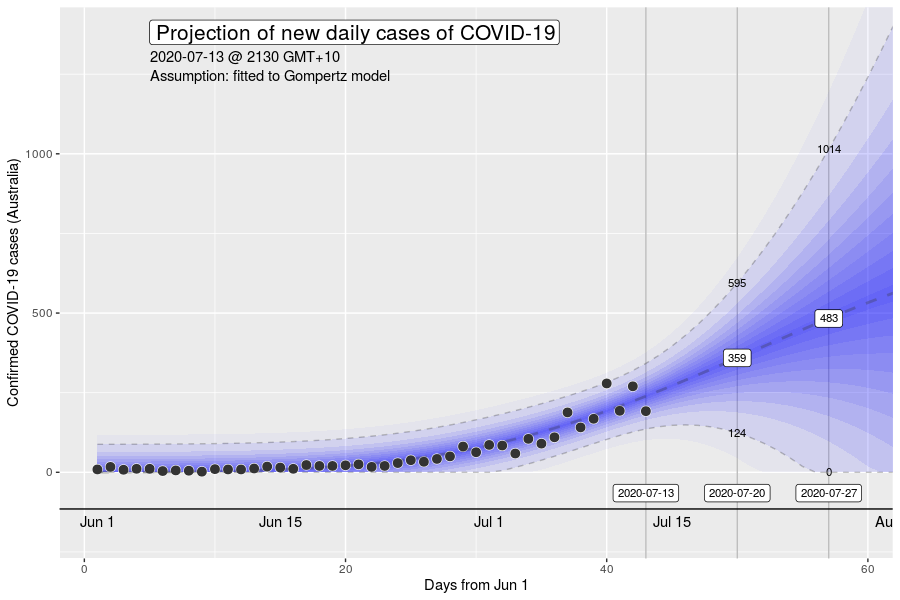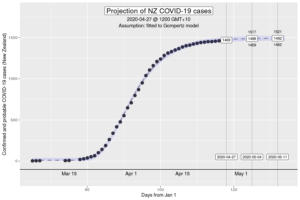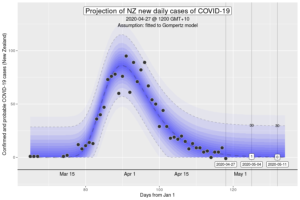Hello everyone! Some of you might be aware that I’ve been publishing some short-term case number projections online on Facebook. These were originally a daily series from March to April. I have restarted the analyses since for about a week with the new Melbourne outbreak. The logic behind these charts is that they fill an information gap. Official data sources only give historic data series, and mainstream media typically only give near term predictions based on opinion.
Chart update 13 July 2020
What’s new?
Today’s update is somewhat within expectation of updates from the previous several days. Of note, however, there is a downtick in the new daily COVID-19 counts. At least part of this is due to the Australian Government Department of Health having revised down the new case counts for some of the previous days. I’ve updated my data to be congruent to the official data, and those of you with good eyes may have noticed that some of the higher spikes have lowered. This isn’t exactly good news, but certainly better than if the revisions were in the other direction. Today’s new case count is less than the projection. One data point isn’t a trend, but I’m hopeful that this might be the earliest signal that the policies to stop community transmission is working.
My experience with this model from the March 2020 was that projections from early on in the epidemic tend to underestimate slightly in the short-term (days), and overestimate in the longer-term (weeks). This bias is something to keep in mind.
Projection of new daily cases of COVID-19 with data up to 13 July 2020

What is this?
The image is a chart of the confirmed daily new cases of COVID-19 in Australia, with a projection for the next 2 weeks. The projection is made using a model by fitting the data since 1 June 2020 to a Gompertz equation using non-linear regression. The dark blue dashed line is the model estimate. The grey dashed lines are the 95% prediction intervals, with the values given at 7 and 14 days into the future. The blue gradations can be understood as the degree of uncertainty in the model projections.
“Gompertz” equation?
The Gompertz function is a type of sigmoid, or “S”-shaped curve. It’s been around since the early 19th century and was initially used to describe and model demographic mortality curves, and hence, well known to actuaries. The Gompertz function can also be used to accurately model biological growth (e.g., epidemics, tumour size, enzymatic reactions). Early in the pandemic, it was identified that it was useful in modelling cumulative cases of COVID-19 from the Chinese outbreaks (Jia et al. arXiv:2003.05447v2 [q-bio.PE]). My experience from the initial outbreak from earlier in the year is that this was also the case in Australia and New Zealand (for instance, NZ data below).


How have the model projections changed over the month?
The video demonstrates how the projections have evolved over time as new daily data have become available. This can give a better sense of where we are headed, given that the model cannot account for changes in context (e.g., policy changes, changes in testing rates, etc.)
My interpretation
The data over the past week is consistent that a new outbreak, with the growth in cases in the “exponential” phase. That the “peak” is not evident in the projections over the next few weeks suggests a possible future of huge numbers of cases IF we don’t implement policies to slow down the rate of transmission. In the model, any estimates beyond a week or two is highly uncertain.
Melbourne went into “lock down” at midnight at the start of 9 July 2020. Assuming that the outbreak is limited to Melbourne, we should expect to see the peak incidence of new daily cases after roughly a week. This was what occurred after the national “lock down” that started 23 March 2020, and this probably provides the best guide of what we might expect.
The big unknown is the degree of community transmission from people who have travelled from Melbourne to other parts of Australia in the past 2 weeks. If this has occurred, it is likely that we’ll start to see new outbreaks in other parts of Victoria and in the other states. There are already a few cases of community transmission in NSW.
Want to know more?
Primary data source is the Australian Government Department of Health COVID-19 website for daily new cases. Analysis done using RStudio Cloud.
